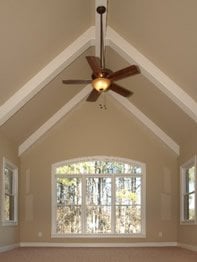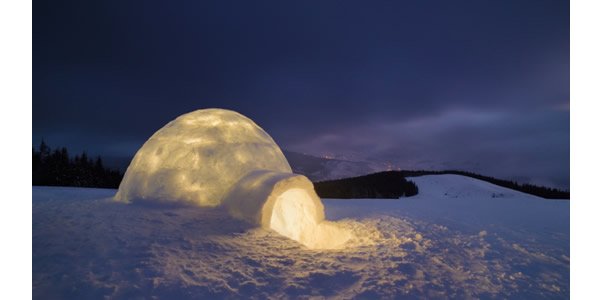A very simple way to reduce energy costs in the middle of winter is to lower the thermostat. It’s a fact that for every degree you lower the thermostat during the winter, you’ll save between 1 and 3% off your heating bill.
But first we need to dispel one idea that is common in the heating ideas of people. Many think that setting your thermostat to one temperature throughout the day and night reduces energy usage. Newton’s Law of Cooling shows us this is a false idea. It shows that the cooler the interior of your home (relative to the outside temperature), the slower the heat loss. For example, if it’s 32° F outside, your home loses more heat energy at 72° F than it does at 62° F because heat transfer slows down as the difference in temperatures gets closer to thermal equilibrium. If it’s 32° F outside, your furnace will run more often over an eight hour period to maintain a 72° F temperature inside than it would if it were set back to 62° F for eight hours. When the furnace is working to recover a higher temperature (say 72° F) it does not work any harder than it would if it were maintaining a 72° F temperature for eight hours. So it is false that maintaining a thermostat temperature over 24 hours saves money.
But how do you determine where to set your thermostat and what hours of the day should it be higher or lower? And how low can you go? Everybody has a different “comfort” level and it’s not exactly an easy question to answer. It can be very subjective.
Scientifically there is some information available. There’s something called a “circadian rhythm.” In layman’s terms this is the body’s clock. It’s a cycle that tells our bodies when to sleep, rise, and eat. It regulates many physiological processes. One’s circadian rhythm is affected by environmental cues like sunlight and temperature. This along with the body’s hormones fluctuate body temperature during the day. You may feel alert and warmer in the morning and may tend to feel a bit colder or drowsy after lunch. As a day winds down your body temperature drops. When sleeping the core body temperature lowers even further and heat radiates from your extremities.
 In fact, a National Institute of Health study found that the best sleep happens as the body reaches something called “thermoneutrality” which is when there is a thermal balance between an organism and its environment. So when the core body temperature drops to about 60° – 66° F and the environmental temperature is close to that—you get a good night’s sleep.
In fact, a National Institute of Health study found that the best sleep happens as the body reaches something called “thermoneutrality” which is when there is a thermal balance between an organism and its environment. So when the core body temperature drops to about 60° – 66° F and the environmental temperature is close to that—you get a good night’s sleep.
With daytime temperatures it’s a different story. A series of experiments by the Society of Heating, Refrigerating and Air-Conditioning Engineers (ASHRAE) showed that people have been socialized to believe that 72° F is the optimum comfortable room temperature.
ASHRAE did one set of experiments where participants did not know the room’s temperature and said they were comfortable. These temperatures ranged from 68° F to 72° F. Statistically the preferred comfortable room temperature ranges from 68° F to 76° F depending on the time of year and the type of clothing worn.
So what’s the easy answer to the question, what is the ideal comfortable thermostat temperature in the middle of winter? Here’s one way to find out what that is for you and your family.
When everyone is home, secretly lower the thermostat setting for a few hours every day. For example, drop it from 72° F to 70° F to see if anyone notices. A few days later you can drop the temperature another degree or two for a few hours. Try going all the way down to 68° F or 67° F. Chances are you won’t get a noticeable reaction from the family till it starts to go below 68° F. When you’ve established the lowest temperature where everyone is pretty comfortable use that during the day.
Now you can start saving on your electricity bill!
And there’s more to know about this. At night, when sleeping, you can go even lower. The thermostat could go all the way down to 62° F at night which makes it easier for your body to achieve the earlier mentioned “thermoneutrality” for a better night’s sleep!
There are a couple other factors that can affect your energy usage in the winter. These include answers to these questions:
 How well insulated and sealed is your home? The better sealed your home is, the longer it takes for your home to lose heat.
How well insulated and sealed is your home? The better sealed your home is, the longer it takes for your home to lose heat.- What is your home’s humidity level? The US EPA recommends 25% to 40% in the winter. Humid air holds more heat and your family will have fewer sinus problems from overly dry air.
- What direction are your ceiling fans spinning? You should have them spin clockwise during fall and winter to circulate warm air properly. You want your fans to draw cool air up from the center of the room and blow warm air down to circulate evenly around the room. This increases comfort, and can inhibit mold growth from poorly insulated exterior walls.
- Do you leave your curtains open at night? Especially if you have thermally-backed window treatments, you can insulate against heat loss through windows and restrict cold air moving across the glass and cooling further. Closed curtains can reduce heat loss by as much as 10%!
Try this out and see if you can find the temperature comfort level of your family in the winter. See if you can lower your energy usage by playing it scientifically and playing it practically. The bottom line, you want to be warm and comfortable but may find you can do that at lower temperatures.
For any energy efficiency needs, contact me at 844-277-0043 or email me at JHall@CesStaff.com.



